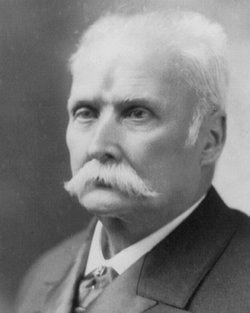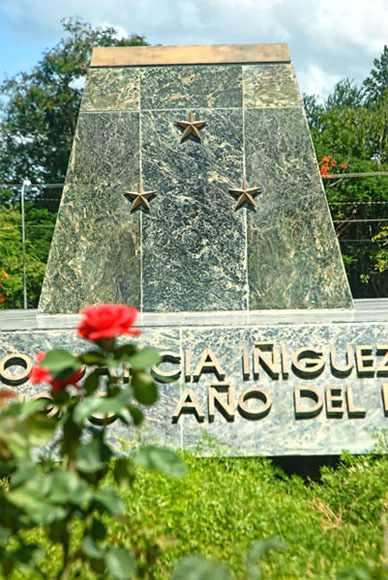As befitted a man of importance of that time, Calixto had a wife, Isabel Vélez Cabrera (?-?), and a good number of mistresses; these women gave birth to many children both legitimate (about 7) and illegitimate (at least six, each to a different woman). A number of his sons, most notable Carlos García Vélez (1867-1963) and BG Calixto Enamorado (1874-1951), fought in his armies. There are approx. 200 descendants of General García, all in the USA.
Died of pneumonia 11 December 1898 at the Raleigh Hotel, Washington DC (demolished).
First buried in Arlington National Cemetery, Arlington, Virginia.
Disinterred and transported aboard the USS Nashville PG-7 to Cuba.
Reburied 11 February 1899 in La Habana.
In 1980 his remains were removed to Plaza de la Revolución, Holguín where his 'polvo y cenizas' rest to this day.
The essay "A Message to García" (March 1899 issue of 'Philistine') by Elbert Green Hubbard (1856-1915) was written in reference to U.S. intelligence officer Andrew Summer Rowan's (1857-1943) successful mission, against great odds, to establish contact with García early in the Spanish–American War. The real message to García was oral and consisted of President William McKinley, Jr.'s (1843-1901) statement that the United States was declaring war on Spain and was eager to have General García's cooperation. Then-Lt Rowan (he eventually made Colonel) was to collect information about Spanish manpower and so on. He made the trip safely, never ran into an evil Spaniard intent on depriving the valiant Cubans of their liberty. Had he been caught, perhaps he would have been shot as a spy, but even vile Spaniards know what a provocation is.
"To take a message to García" means accepting an extremely difficult challenge; "To send a message to García" means evacuating the bowels. The speaker must be careful of context; nevertheless, the fine difference between "to send" and "to take" is often lost in an emunctory context.
The essay was made into two American films: the 1916 silent 'A Message to García' with García played by Charles Sutton (1856-1935) and "the merry-serious girl whose expressive eyes and face mirror emotions more effectively than a hundred voices" Mabel Trunnelle (1879-1981) as the love interest.
In 1936 along came the talkie remake 'A Message to Garcia' featuring Enrique Acosta (1870-1949) as García, Wallace Fitzgerald Beery (1885-1949), John Boles (1895-1969) as Rowan, and Barbara Stanwyck (1907-1990) as Srta. Raphaelita Maderos, who glamorously guides Rowan through the fetid jungles. "As undocumented a piece of historical claptrap as the film city has produced," declared NYT film critic Frank Stanley Nugent (1908-1965).
As befitted a man of importance of that time, Calixto had a wife, Isabel Vélez Cabrera (?-?), and a good number of mistresses; these women gave birth to many children both legitimate (about 7) and illegitimate (at least six, each to a different woman). A number of his sons, most notable Carlos García Vélez (1867-1963) and BG Calixto Enamorado (1874-1951), fought in his armies. There are approx. 200 descendants of General García, all in the USA.
Died of pneumonia 11 December 1898 at the Raleigh Hotel, Washington DC (demolished).
First buried in Arlington National Cemetery, Arlington, Virginia.
Disinterred and transported aboard the USS Nashville PG-7 to Cuba.
Reburied 11 February 1899 in La Habana.
In 1980 his remains were removed to Plaza de la Revolución, Holguín where his 'polvo y cenizas' rest to this day.
The essay "A Message to García" (March 1899 issue of 'Philistine') by Elbert Green Hubbard (1856-1915) was written in reference to U.S. intelligence officer Andrew Summer Rowan's (1857-1943) successful mission, against great odds, to establish contact with García early in the Spanish–American War. The real message to García was oral and consisted of President William McKinley, Jr.'s (1843-1901) statement that the United States was declaring war on Spain and was eager to have General García's cooperation. Then-Lt Rowan (he eventually made Colonel) was to collect information about Spanish manpower and so on. He made the trip safely, never ran into an evil Spaniard intent on depriving the valiant Cubans of their liberty. Had he been caught, perhaps he would have been shot as a spy, but even vile Spaniards know what a provocation is.
"To take a message to García" means accepting an extremely difficult challenge; "To send a message to García" means evacuating the bowels. The speaker must be careful of context; nevertheless, the fine difference between "to send" and "to take" is often lost in an emunctory context.
The essay was made into two American films: the 1916 silent 'A Message to García' with García played by Charles Sutton (1856-1935) and "the merry-serious girl whose expressive eyes and face mirror emotions more effectively than a hundred voices" Mabel Trunnelle (1879-1981) as the love interest.
In 1936 along came the talkie remake 'A Message to Garcia' featuring Enrique Acosta (1870-1949) as García, Wallace Fitzgerald Beery (1885-1949), John Boles (1895-1969) as Rowan, and Barbara Stanwyck (1907-1990) as Srta. Raphaelita Maderos, who glamorously guides Rowan through the fetid jungles. "As undocumented a piece of historical claptrap as the film city has produced," declared NYT film critic Frank Stanley Nugent (1908-1965).
Advertisement
Records on Ancestry
Sponsored by Ancestry
Advertisement





